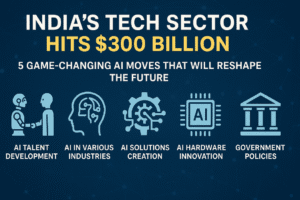India’s Tech Sector Hits $300 Billion: 5 Game-Changing AI Moves That Will Reshape the Future
India’s tech sector, on pace to hit $300 billion by 2026, faces a transformative era as agentic AI reshapes its trajectory. While the industry adds 126,000 jobs this year, AI threatens to disrupt the IT services model—historically reliant on junior talent—by amplifying senior developers’ productivity, forcing firms to reimagine workforce structures. Leaders like Dr. Ranjit Tinaikar urge homegrown innovation, stressing AI must solve India’s unique challenges (e.g., agriculture, healthcare) rather than mimic Western trends.
Regulatory caution prevails: sector-specific policies, not sweeping mandates, are key to balancing innovation and control. With AI compressing traditional profit pyramids, reskilling 7.2 million engineers in niche domains (AI ethics, LLMs) becomes critical. As India prepares to host the 2026 Global AI Summit, its focus on equitable AI access, climate resilience, and global-standard advocacy positions it to lead the next phase of tech evolution—blending economic ambition with inclusive, localized solutions.

India’s Tech Sector Hits $300 Billion: 5 Game-Changing AI Moves That Will Reshape the Future
India’s tech sector is poised to cross a historic $300 billion revenue milestone in FY2026, driven by explosive growth in software services and products. With 126,000 new jobs projected this year, the industry now supports 5.8 million workers, cementing its role as a cornerstone of the nation’s economy. But as agentic AI emerges as the next frontier, India faces both unprecedented opportunities and existential challenges. Here’s how the country is steering its AI future.
- Agentic AI: A Double-Edged Sword for India’s Tech Ecosystem
Agentic AI—systems capable of autonomous decision-making—promises to reshape industries, from healthcare to finance. For India, this technology could unlock solutions to uniquely local challenges, such as optimizing agricultural supply chains or democratizing access to education in regional languages. However, its rise also threatens to disrupt the $250 billion IT services sector, which relies heavily on labor-intensive outsourcing models.
Key Insight: “AI isn’t just a tool—it’s a structural disruptor,” warns Dr. Ranjit Tinaikar, CEO of Ness Digital Engineering. “The traditional IT services pyramid, where profits hinge on junior talent, is collapsing. Senior developers leveraging AI tools now deliver outsized value, forcing firms to rethink workforce strategies.”
- Solving India’s Problems, India’s Way
India’s AI strategy is being shaped by its socioeconomic realities. With 1.3 billion people facing disparities in healthcare, education, and infrastructure, the focus is on homegrown innovation. Dr. Tinaikar emphasizes the need to avoid “copy-paste” approaches from the West.
- Case in Point: India’s telecom revolution (Geo in Telecom) tailored global technology to local needs, just as WhatsApp became the de facto communication tool over SMS. Similarly, AI solutions must address hyper-local issues—think predictive analytics for monsoon farming or AI-driven diagnostics for rural clinics.
“Entrepreneurs must resist chasing Silicon Valley trends and instead solve problems that matter here,” he asserts.
- Regulation: Striking the Balance Between Control and Innovation
Global AI regulation debates offer cautionary tales. The EU’s sweeping 3,000-page AI Act, while well-intentioned, risks stifling innovation with broad mandates. In contrast, the U.S. leans toward sector-specific oversight, such as the FDA’s AI-enabled medical tools approvals.
India’s Path Forward:
- Domain-Specific Guardrails: Empower industries like healthcare and finance to self-regulate AI use, guided by high-level ethical principles.
- Avoid Overregulation: Policies must nurture startups, not burden them. For instance, RBI could frame AI guidelines for fintech, while agriculture ministries oversee AI in farming.
“Generic regulations ignore nuance. Let those who understand the domain lead,” says Tinaikar.
- The IT Services Shake-Up: From Labor Arbitrage to AI-Driven Value
India’s IT sector, which contributes 10% of GDP, faces a reckoning. Studies reveal AI boosts senior developers’ productivity more than juniors, upending the “pyramid model” where profits rely on cheap, entry-level labor.
Implications:
- Reshaped Workforce Demand: While AI reduces barriers to coding, demand for niche skills (AI ethics, domain-specific LLMs) will surge.
- Economic Pressures: Firms must reinvest savings from automation into upskilling programs to retain competitiveness.
“The pyramid isn’t disappearing—it’s evolving. Companies that reskill talent and integrate AI ethically will thrive,” notes Tinaikar.
- Workforce 2.0: Reskilling for the AI Era
With 7.2 million software engineers, India’s talent pool is vast but at a crossroads. AI tools like GitHub Copilot are doubling coder productivity, but junior roles risk obsolescence without reinvention.
Priorities for 2026:
- Upskilling Initiatives: Government-industry partnerships to train engineers in AI collaboration, prompt engineering, and domain specialization.
- Education Reform: Integrate AI literacy into STEM curricula, emphasizing critical thinking over rote coding.
- Global Leadership: The 2026 AI Summit and Beyond
India’s hosting of the 2026 Global AI Summit signals its ambition to lead the conversation. By convening global stakeholders, the nation aims to:
- Advocate for equitable AI access in developing economies.
- Showcase homegrown innovations (e.g., AI for climate resilience).
- Shape international standards that reflect diverse needs.
The Road Ahead
India’s tech sector stands at an inflection point. Agentic AI offers a chance to leapfrog into advanced economies while addressing systemic inequities. Yet, success hinges on balancing innovation with inclusivity, regulation with agility, and global ambition with local relevance. As Dr. Tinaikar puts it: “AI isn’t just about technology—it’s about rewriting India’s growth story on its own terms.”
For policymakers and business leaders, the mandate is clear: Prioritize adaptability, invest in human capital, and harness AI as a force for equitable progress. The world will be watching.
You must be logged in to post a comment.